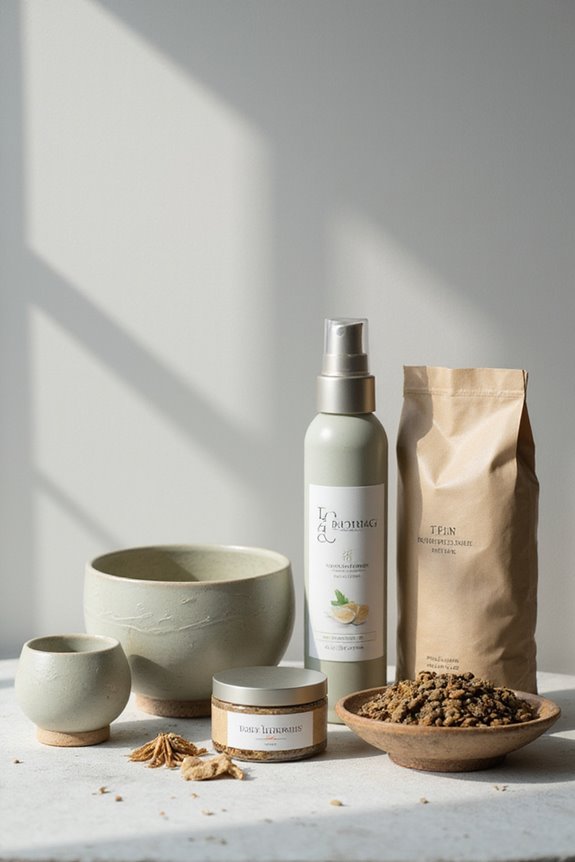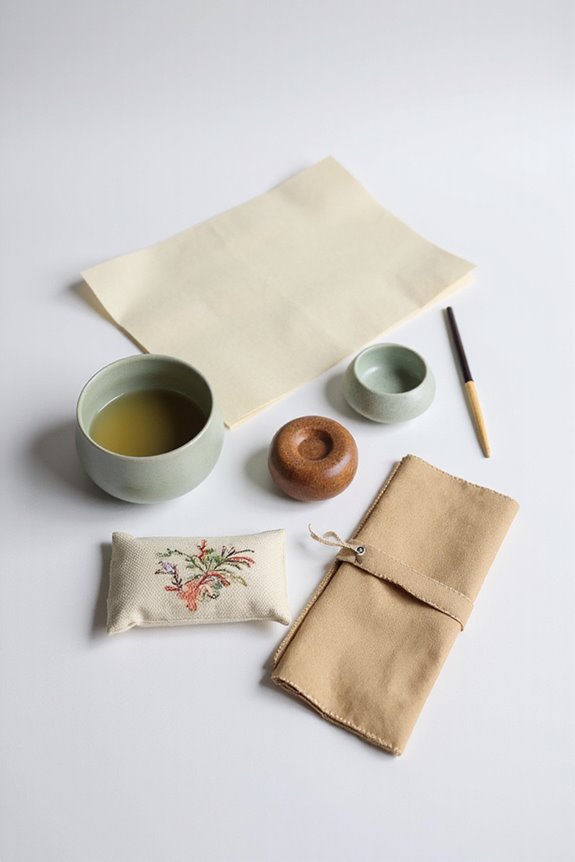Authentic Korean cultural products include traditional crafts like hanji paper, which uses mulberry tree fibers, and najeonchilgi, where mother-of-pearl is inlaid into lacquered items. Korean ceramics, such as Goryeo celadon and moon jars, showcase meticulous artistry and historical significance. Hanbok, the traditional dress, reflects cultural values through its vibrant designs and patterns. Fermented foods like kimchi and doenjang offer nutritional benefits while embodying culinary traditions. To discover more about the authenticity of these products, keep reading.
Key Takeaways
- Traditional handcrafted items like hanji paper and najeonchilgi showcase authenticity through their unique materials and techniques.
- Authentic Korean ceramics, such as Goryeo celadon and moon jars, demonstrate intricate craftsmanship and cultural significance.
- The hanbok, with its vibrant colors and traditional designs, reflects cultural authenticity while adapting to modern styles.
- Fermented foods like kimchi and doenjang are essential staples in Korean cuisine, emphasizing the use of traditional preservation methods.
- Sustainable dining practices, such as using wooden chopsticks, contribute to authentic Korean dining experiences.
Traditional Korean Crafts
When we explore traditional Korean crafts, it becomes evident that these art forms embody a rich cultural heritage, reflecting the history and values of the Korean people. Among these crafts, hanji techniques stand out, utilizing the strong fibers of mulberry trees to create durable paper for manuscripts and artistic expressions. Artisans today often enhance hanji’s qualities with wax for improved water resistance, making it versatile for various uses. Similarly, najeonchilgi artistry showcases the intricate process of inlaying mother-of-pearl pieces into lacquered items, offering unique decorative elements for boxes and furniture. Both crafts highlight a dedication to material integrity and aesthetic refinement, with active workshops in places like Insadong allowing us to engage and appreciate the traditional skills passed down through generations.
Authentic Korean Ceramics and Pottery
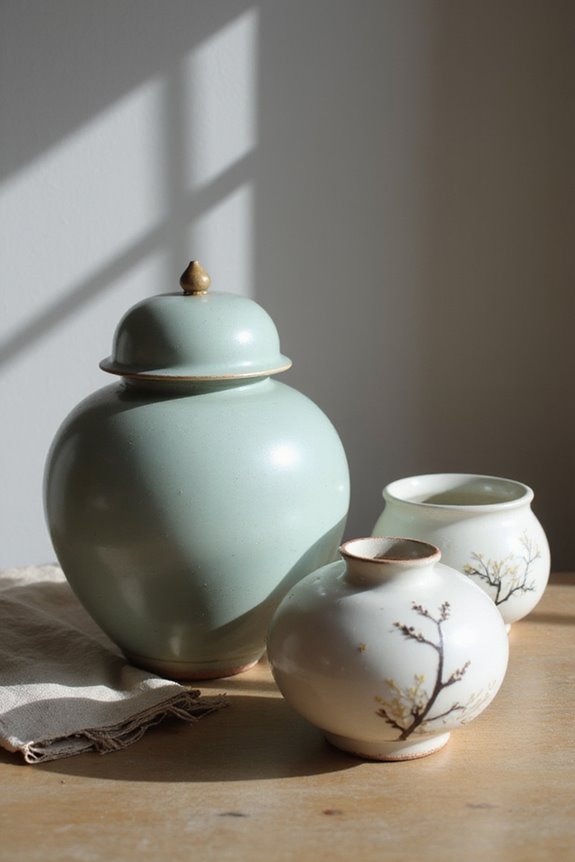
Authentic Korean ceramics and pottery represent a profound heritage, showcasing techniques developed over centuries that emphasize both artistic expression and functional design. Techniques such as celadon, characterized by its bluish-green glazes, highlight the meticulous craftsmanship involved. Goryeo celadon and its intricate inlaid designs exemplify this art form. Buncheong ware, bridging earthenware and porcelain, features distinctive slip-painted surfaces and robust forms, such as the iconic moon jars that symbolize balance in design. Local materials, including clay and wood ash glazes, are essential, as is the use of traditional kilns fueled by wood, which influence color and texture. Craftsmanship can take months or years, reflecting the dedication to producing authentic, high-quality pieces that resonate with Korea’s rich cultural legacy.
The Significance of Hanbok in Korean Culture
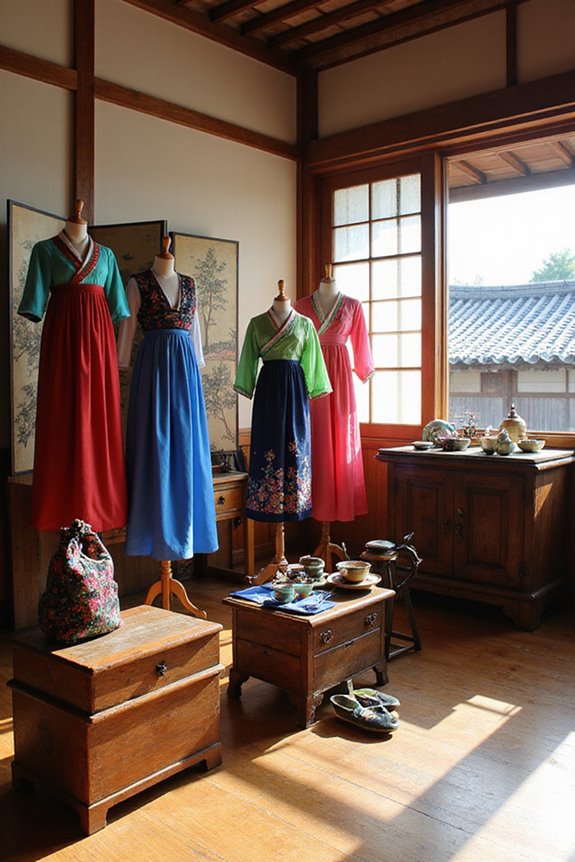
Hanbok holds a pivotal role in Korean culture, serving as more than just traditional attire; it embodies the nation’s history, values, and artistic expression. The Hanbok symbolism is deeply intertwined with Confucian ideals, emphasizing modesty and hierarchy, which reflects aspects of Korean identity. Traditionally, designs varied by social rank, where bright colors and intricate embroidery were reserved for the elite, while simpler styles represented the common populace. Hanbok aesthetics are distinguished by their elegant silhouettes and vibrant color palettes, inspired by nature. As Korea evolves, there’s been a modern revival in Hanbok usage, merging traditional craftsmanship with contemporary influences, ensuring it remains an essential expression of our cultural heritage during significant life events and celebrations.
Exploring Korean Cuisine and Fermented Foods
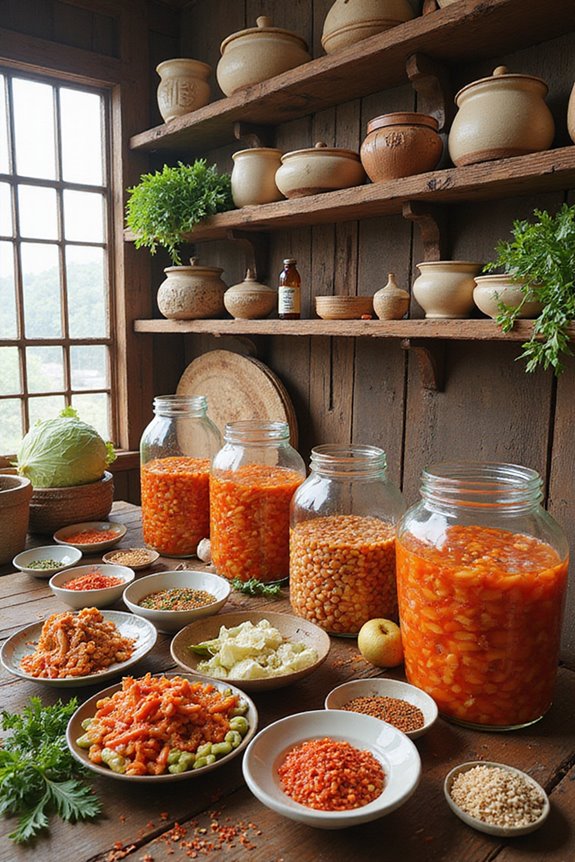
Korean cuisine, renowned for its vibrant flavors and health benefits, is deeply enriched by its fermented foods, which play an essential role in both traditional and modern diets. A staple, kimchi is available in numerous varieties, like radish and cucumber kimchi, and is packed with probiotics that enhance fermented health. Doenjang, a robust fermented soybean paste, serves as a fundamental base for many sauces and soups, while gochujang adds depth to dishes like bibimbap. Cheonggukjang and nokdujang also contribute unique flavors to stews and pancakes. These fermented options not only enhance taste but also provide crucial nutrients, helping lower cholesterol and stabilize blood sugar, making them a critical element of Korean culinary practices and their health benefits. Additionally, the use of traditional ingredients like fermented soybeans is significant for achieving true Korean flavors in cooking.
Traditional Korean Music and Dance Forms
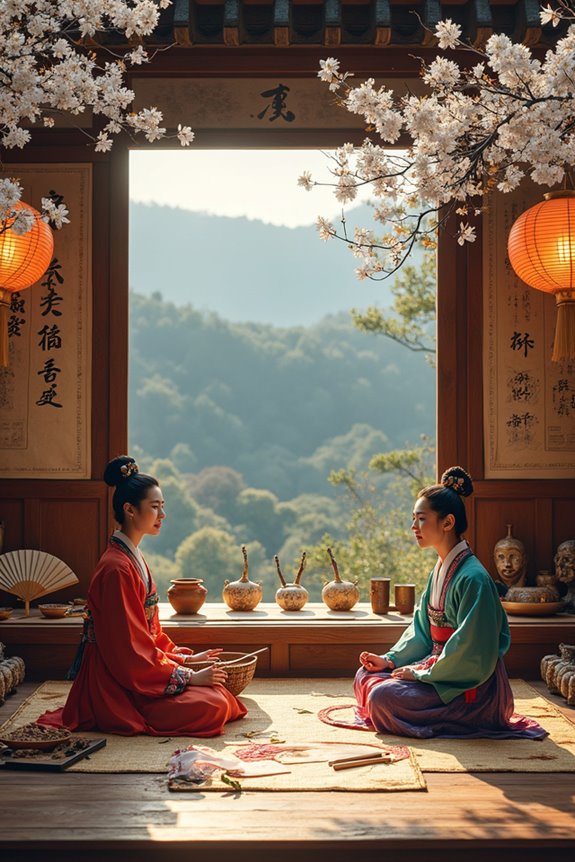
Music and dance have long been integral components of cultural expression, particularly in regions steeped in history, like Korea. Traditional music such as gugak, which means “national music,” has been performed since the 15th century, incorporating unique instruments like the gayageum and geomungo. P’ansori, a narrative folk music form, emerged in the 18th century, conveying stories of Korean legends through rhythmic vocalization. Meanwhile, dance forms like jeongjae evolved from court traditions and incorporate both native and Tang-derived styles. The sword dance, tracing back to Silla, showcases ceremonial significance within royal performances. These traditional music and dance forms not only highlight historical continuity but also serve as essential mediums for cultural identity within Korea’s dynamic heritage.
Cultural Authenticity in Modern Interpretations
As cultural narratives evolve, the question of authenticity in modern interpretations of traditional Korean elements becomes increasingly complex. We see cultural reinterpretation as both an opportunity and a challenge in authenticity debates. For instance, dishes like Korean fried chicken blend global influences yet are marketed as authentically Korean. This raises questions about the integrity of traditional recipes. Similarly, modern adaptations of hanbok can reflect personal style while still retaining their cultural significance. As globalization continues, we witness an ongoing tension between the preservation of heritage and the adaptation to contemporary contexts, indicating that cultural authenticity isn’t static but rather dynamic. Ultimately, maneuvering through these interpretations helps us better understand the evolving identity of Korean culture in a globalized world. Additionally, traditional ceramic bowls play a vital role in enhancing the authenticity of Korean dining experiences.
The Role of Globalization in Korean Cultural Products
Globalization has considerably shaped the landscape of cultural products originating from Korea, leading to an international marketplace that embraces diverse offerings. The Korean Wave, or Hallyu, has greatly increased global demand for entertainment, food, and beauty products. As these products expand into new markets, cultural adaptation becomes essential to cater to varying tastes and preferences. For instance, Korean cuisine is often modified to appeal to international palates, balancing authenticity and market requirements. Additionally, global marketing strategies have enhanced visibility, allowing Korean brands to thrive worldwide. The government’s support for cultural exports, alongside innovative marketing techniques, drives the diversification of Korean cultural products. This dynamic interaction between globalization and cultural exchange continues to shape perceptions and bolster economic growth. Notably, the popularity of Korean skincare products has also contributed to the global fascination with Korea’s beauty standards and routines.
Preserving Korean Heritage Through Crafts and Traditions
To preserve Korean heritage, the importance of traditional crafts and practices cannot be overstated, particularly in a rapidly changing global landscape. Techniques like Najeonchilgi and Ipsa highlight our rich cultural history, yet artisan challenges threaten their survival. The labor-intensive nature of these crafts leads to a decline in skilled artisans, as younger generations often seek less strenuous careers. Additionally, competition from cheaper alternatives, along with environmental concerns surrounding materials, complicates cultural preservation efforts. Fortunately, initiatives to educate and train youth, alongside modern adaptations of these crafts for contemporary markets, offer pathways for revitalization. By recognizing the value of these traditions, we can guarantee their continuity, fostering a deeper connection with our heritage and preserving it for future generations. The rise of wooden chopsticks as a sustainable dining option also reflects a growing appreciation for authentic Korean culture.
Frequently Asked Questions
How Can I Identify Authentic Korean Crafts in Markets?
They say, “The devil’s in the details.” To spot authentic Korean crafts, we should focus on craft quality, avoid mass-produced items, and follow market tips like inspecting materials and craftsmanship for uniqueness.
What Modern Influences Affect Traditional Korean Food Authenticity?
We notice modern influences shaping traditional Korean food authenticity through fusion cuisine, blending modern ingredients with classic recipes. These adaptations reflect our evolving culinary landscape while offering fresh experiences without completely losing our cultural heritage.
Are There Korean Cultural Festivals Celebrating Handcrafted Products?
We can explore various cultural exhibitions and craft fairs celebrating Korean handcrafted products. These festivals showcase the beauty of traditional crafts, allowing us to appreciate and support the artisans preserving Korea’s rich cultural heritage.
How Do I Care for Authentic Hanbok Garments?
For hanbok maintenance, we should opt for professional dry cleaning and store garments in breathable bags. Let’s avoid high heat while ironing and always keep our hanbok clean and dry to guarantee proper garment storage.
Where Can I Experience Traditional Korean Music Performances?
We can immerse ourselves in traditional Korean music by visiting venues like the National Gugak Center and checking their live performance schedules. It’s a fantastic way to experience the rich cultural heritage together!

